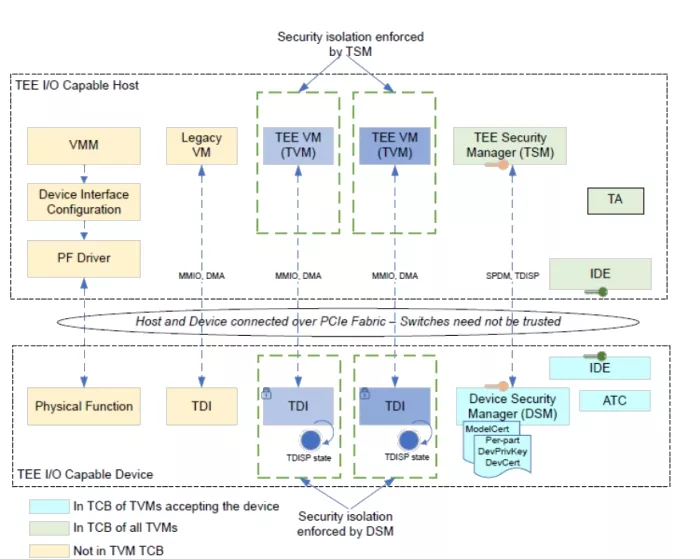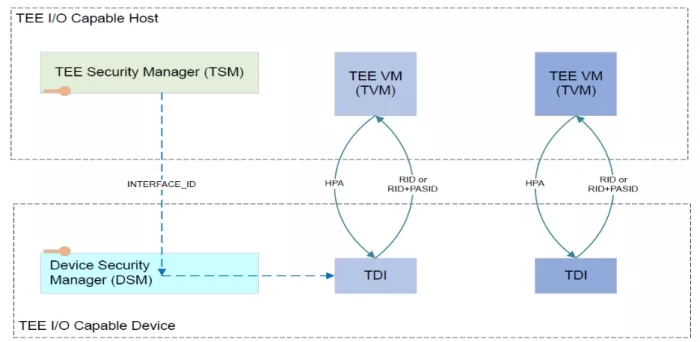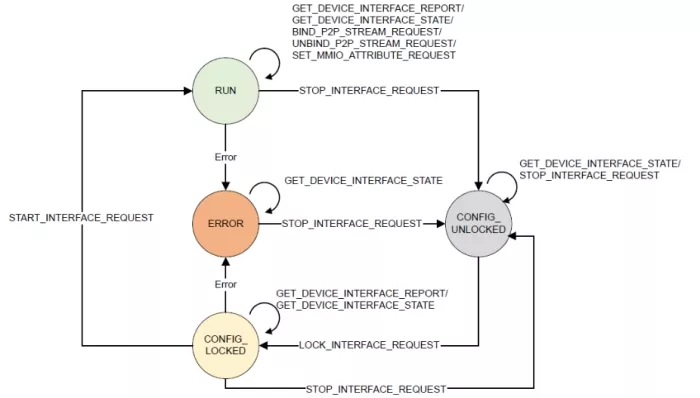Verification of PCIe's TDISP for Device Interface Security
The TEE Device Interface Security Protocol (TDISP) is a critical component in ensuring the Interface security of devices operating within a Trusted Execution Environment (TEE). It gives a set of rules designed to prevent and mitigate security threats in devices managed by a Trusted Computing Base (TCB). The TCB, comprising software, hardware, and firmware, enforces these security rules to ensure system integrity. Acting as the upper layer of security, TDISP serves as a guardian layer for Integrity and Data Encryption (IDE). This blog provides an overview of TDISP, its requirements, setup, and the challenges faced during its verification.
Key Components
- Trusted Execution Environment (TEE): A secure area within a device where operations are considered trustworthy.
- TEE Virtual Machine (TVM): A virtual machine within the TEE.
- TEE Security Manager (TSM): Manages security rules on the host.
- TEE Device Interface (TDI): Managed by the TVM, it can be an entire device or a specific function.
- Device Security Manager (DSM): Manages security rules on the device.
- VMM (Virtual Machine Monitor): Manages virtual machines.
- Legacy VM: A standard virtual machine without TEE capabilities.
- Device Interface Configuration: Manages how devices are exposed to VMs.
- PF Driver (Physical Function Driver): Interfaces with the physical device.

Figure 1: TDISP architecture with example host and device and logical communication paths
How TDISP Protects Against Attacks
TDISP is designed to safeguard PCIe devices operating within a TEE by addressing multiple vectors of potential attacks. It ensures device authenticity and integrity through cryptographic verification using the CMA/SPDM protocol, which helps prevent tampering with critical identifiers like Vendor ID and Device ID. To secure communication between the device and host, TDISP leverages IDE, protecting data from physical interception or manipulation. It also enforces strict control over TDI management, mitigating risks associated with unauthorized changes to DMA and interrupt remapping tables. Furthermore, TDISP isolates sensitive data and enforces access control to prevent physical functions from influencing the security properties of virtual machines. Through these layered defenses, TDISP establishes a robust framework for protecting PCIe devices in secure computing environments.

Figure 2: Identification of Requests
TDISP Messages
TDISP uses a specific set of messages transmitted via CMA/SPDM over Data Object Exchange (DOE). These messages include:
- GET_TDISP_VERSION: Initiates version negotiation.
- LOCK_INTERFACE_REQUEST: Locks the configuration space.
- START_INTERFACE_REQUEST: Moves the TDI to the RUN state.
- STOP_INTERFACE_REQUEST: Moves the TDI to the Unlock state.
- TDISP_ERROR: Response to error conditions such as version inconsistencies, nonce mismatch, IDE insecure state, etc.
- TDISP_VERSION: Response to GET_TDISP_VERSION with version of TDISP.
- LOCK_INTERFACE_RESPONSE: Response to Lock the configuration space.
- START_INTERFACE_RESPONSE: Response to move the TDI to the RUN state.
- STOP_INTERFACE_RESPONSE: Response to move the TDI to the Unlock state
TDISP State Machine
Each TDI has an internal state machine representing its security state. The states include:
- CONFIG_UNLOCKED: Default state, data is not secure.
- CONFIG_LOCKED: Configuration space is locked.
- RUN: TDI resources are accessible.
- ERROR: Indicates a security breach or error condition.
Figure 3 TDISP Finite State Machine
TDISP Requirements and Setup
To enable TDISP, the following are required:
- Data Object Exchange (DOE): For transmitting CMA/SPDM messages.
- Component Measurement and Authentication (CMA-SPDM): For device authentication.
- Integrity and Data Encryption (IDE): For secure data transfer.
Verification Challenges
Verifying TDISP involves several challenges:
Integration with Existing Systems:
- Ensuring TDISP integrates seamlessly with existing security protocols.
- Managing dependencies on other components like DOE and CMA/SPDM
FSM Transitions:
- Ensuring seamless transitions of the finite state machine (FSM) under various scenarios.
Error Handling:
- Validating mechanisms for handling unpredictable failures, such as nonce mismatches and version inconsistencies.
IDE Encryption:
- Validating IDE encryption under different security states to ensure robust protection against data breaches. Transitioning to IDE insecure state to validate TDI behaviour.
Reset and Error States:
- Ensuring correct behavior of TDISP transactions during reset and error states, requiring extensive debugging and iterative refinements.
Conclusion
As the demand for secure and high-performance computing continues to grow, protocols like TDISP are becoming essential in safeguarding PCIe devices within Trusted Execution Environments. TDISP provides a structured and robust framework that addresses key security concerns from device authentication and secure communication to interface management and access control. TDISP verification requires a deep understanding of system architecture, validation of state transitions, and careful integration with existing security mechanisms. Despite these challenges, the successful implementation and verification of TDISP can significantly enhance the trustworthiness of modern computing platforms.
Learn More
- For more information on how Cadence PCIe Verification IP and TripleCheck VIP enable users to confidently verify IDE, see our VIP for PCI Express, VIP for Compute Express Link, and TripleCheck for PCI Express
- For more information on PCIe in general, and on the various PCI standards, see the PCI-SIG website
- For more information on CXL in general, see the CXL consortium website
- If you have more feedback or need more information, reach out to us at talk_to_vip_expert@cadence.com
Related Semiconductor IP
- Simulation VIP for PCIe
- Simulation VIP for CXL
- Configurable PCI Express 4.0 Link Controller
- PCI Express PHY
- Multi-Channel Flex DMA IP Core for PCI Express
Related Blogs
- New PCIe TDISP Architecture Secures Device Interfaces with Virtual Servers
- Intel’s Atom-based Tunnel Creek SOC with integrated PCIe interface opens new era for embedded developers
- NVMe storage-optimized PCIe interface gets an Interoperability Lab at University of New Hampshire
- Cadence support for the Open NAND Flash Interface (ONFI) 3.0 controller and PHY IP solution + PCIe Controller IP opening the door for NVM Express support
Latest Blogs
- ReRAM in Automotive SoCs: When Every Nanosecond Counts
- AndeSentry – Andes’ Security Platform
- Formally verifying AVX2 rejection sampling for ML-KEM
- Integrating PQC into StrongSwan: ML-KEM integration for IPsec/IKEv2
- Breaking the Bandwidth Barrier: Enabling Celestial AI’s Photonic Fabric™ with Custom ESD IP on TSMC’s 5nm Platform

